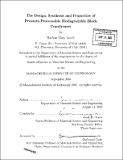| dc.contributor.advisor | Anne M. Mayes. | en_US |
| dc.contributor.author | Lovell, Nathan Gary | en_US |
| dc.contributor.other | Massachusetts Institute of Technology. Dept. of Materials Science and Engineering. | en_US |
| dc.date.accessioned | 2006-07-31T15:17:14Z | |
| dc.date.available | 2006-07-31T15:17:14Z | |
| dc.date.copyright | 2005 | en_US |
| dc.date.issued | 2005 | en_US |
| dc.identifier.uri | http://hdl.handle.net/1721.1/33614 | |
| dc.description | Thesis (S.M.)--Massachusetts Institute of Technology, Dept. of Materials Science and Engineering, 2005. | en_US |
| dc.description | Includes bibliographical references (p. 89-95). | en_US |
| dc.description.abstract | In this thesis, biodegradable block copolyesters were specifically designed and synthesized for their susceptibility to pressure-induced mixing. These baroplastic materials are capable of being processed and molded through the application of pressure at temperatures far below those needed in traditional melt-processing of biodegradable polyesters. Pressure molding at low temperatures reduces the danger of chain degradation during processing that is ubiquitous in biodegradable plastics. The compressible regular solution model (CRS), in combination with group contribution (GC) methods and pressure-volume-temperature (PVT) data, was used to predict the phase behavior and pressure-induced miscibility of several block copolymer systems. Small-angle neutron scattering (SANS) experiments confirmed that amorphous forms of the poly([epsilon]-caprolactone-ran-5 ethylene ketal [epsilon]-caprolactone)-block-poly(lactic acid) (PmCL-b-PLA) system exhibit pressure- induced miscibility, and small angle x-ray scattering (SAXS) revealed that the position of the upper disorder-to-order temperature (UDOT) in those systems is near the values predicted by the CRS model. | en_US |
| dc.description.abstract | (cont.) Differential scanning calorimetry measurements suggest that poly(1,5-dioxepan-2-one)-block-poly(lactic acid) (PDXO-b-PLA), which was calculated as being more miscible than PmCL-b-PLA by the CRS model, resides in a mixed state at ambient pressure and temperature. The CRS predictions were found to be more accurate with component parameters derived directly from GC than from PVT data. Pressure processing of multiple systems at low temperatures was conducted, and the mechanical properties of these biodegradable baroplastics (bbps) were measured. Crystallinity plays a complex role in baroplastic behavior that has not been fully elucidated. The strain-to-break and modulus of the bbps is good, but somewhat reduced relative to solvent-cast or melt-processed samples. The tunability of the properties of bbps, combined with their low-temperature processability, make them promising candidates for biomedical materials and environmentally friendly plastics. | en_US |
| dc.description.statementofresponsibility | by Nathan Gary Lovell. | en_US |
| dc.format.extent | 95 p. | en_US |
| dc.format.extent | 4539611 bytes | |
| dc.format.extent | 4543521 bytes | |
| dc.format.mimetype | application/pdf | |
| dc.format.mimetype | application/pdf | |
| dc.language.iso | eng | en_US |
| dc.publisher | Massachusetts Institute of Technology | en_US |
| dc.rights | M.I.T. theses are protected by copyright. They may be viewed from this source for any purpose, but reproduction or distribution in any format is prohibited without written permission. See provided URL for inquiries about permission. | en_US |
| dc.rights.uri | http://dspace.mit.edu/handle/1721.1/7582 | |
| dc.subject | Materials Science and Engineering. | en_US |
| dc.title | The design, synthesis and properties of pressure-processable biodegradable block copolymers | en_US |
| dc.type | Thesis | en_US |
| dc.description.degree | S.M. | en_US |
| dc.contributor.department | Massachusetts Institute of Technology. Department of Materials Science and Engineering | |
| dc.identifier.oclc | 64390989 | en_US |
